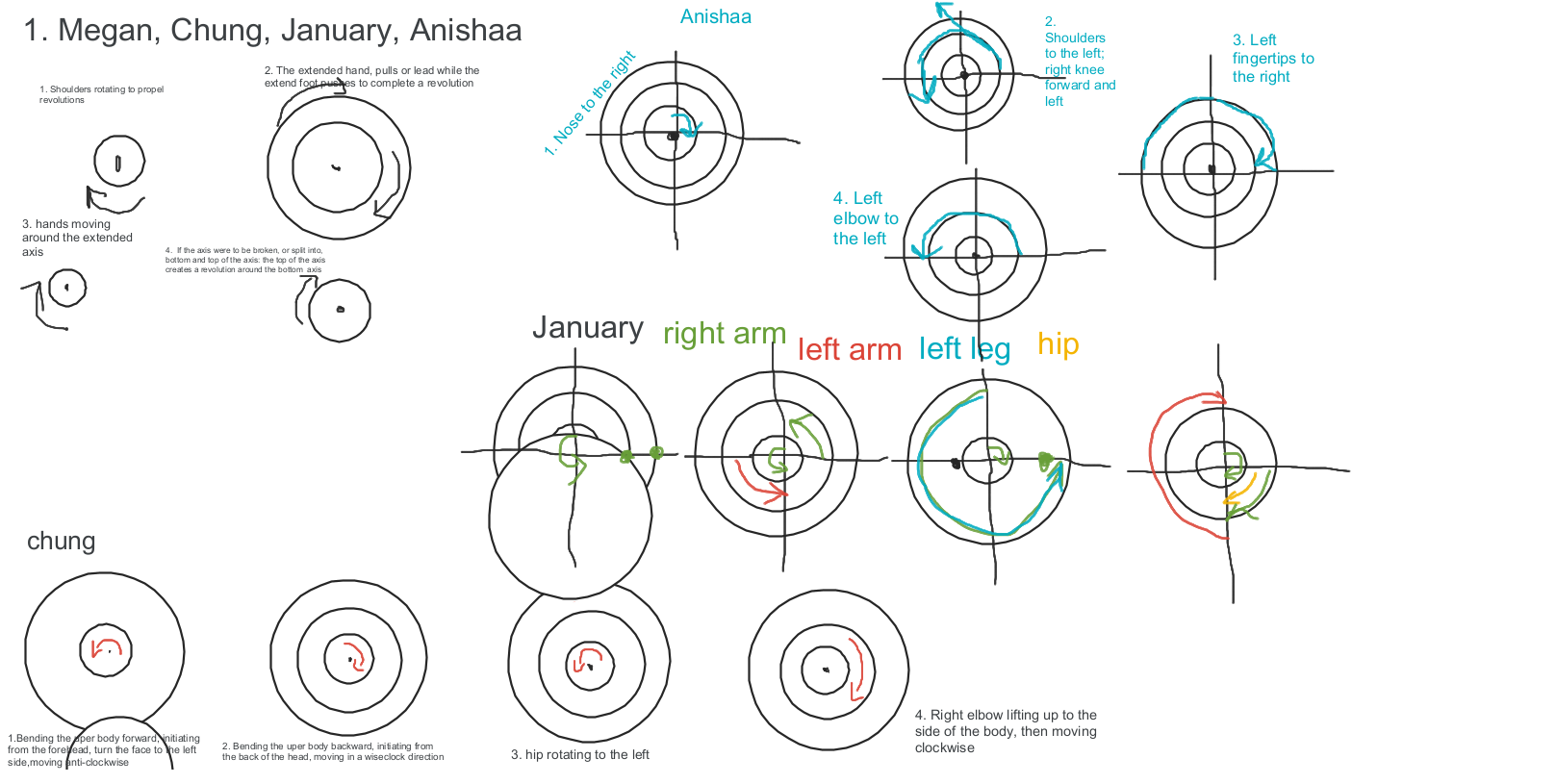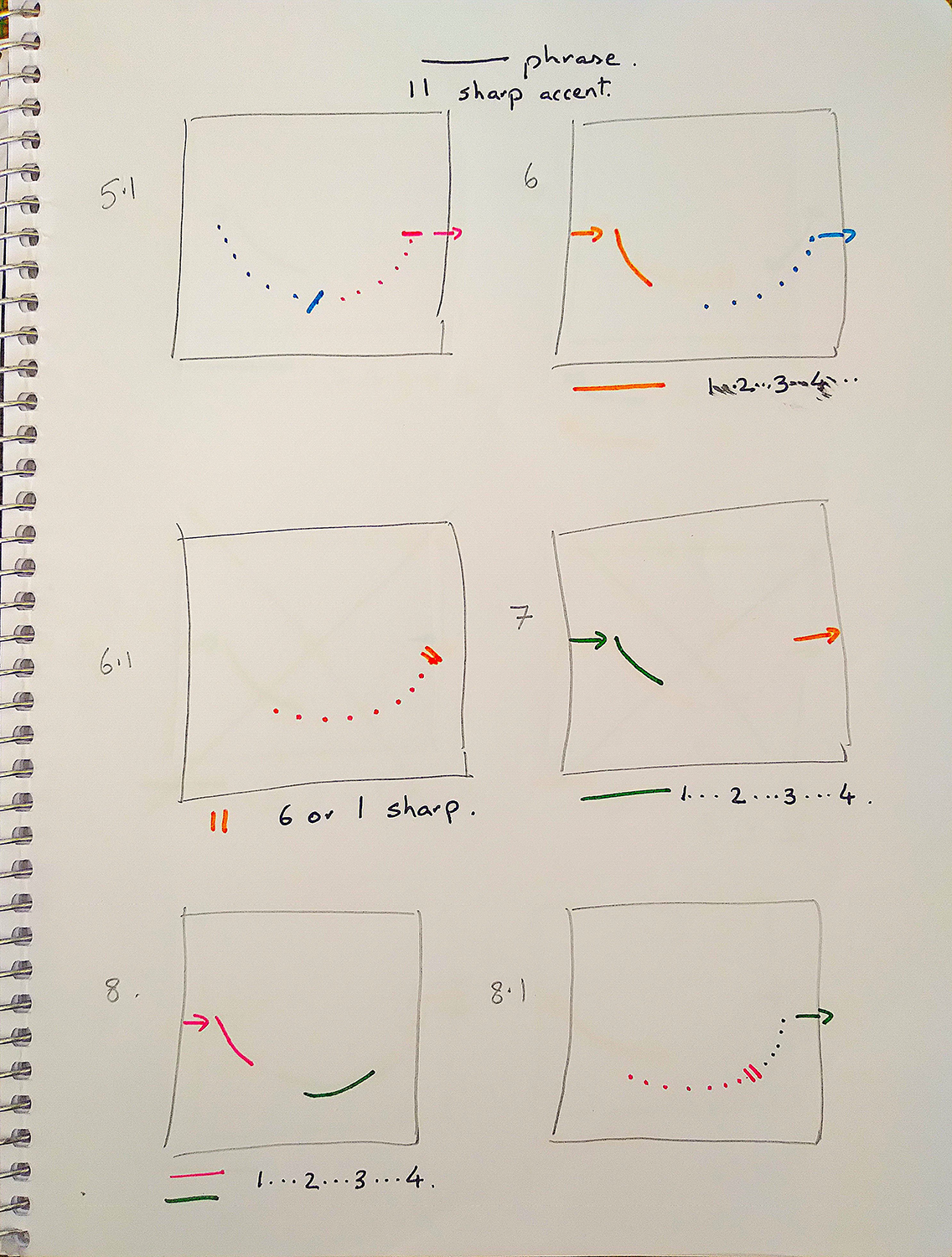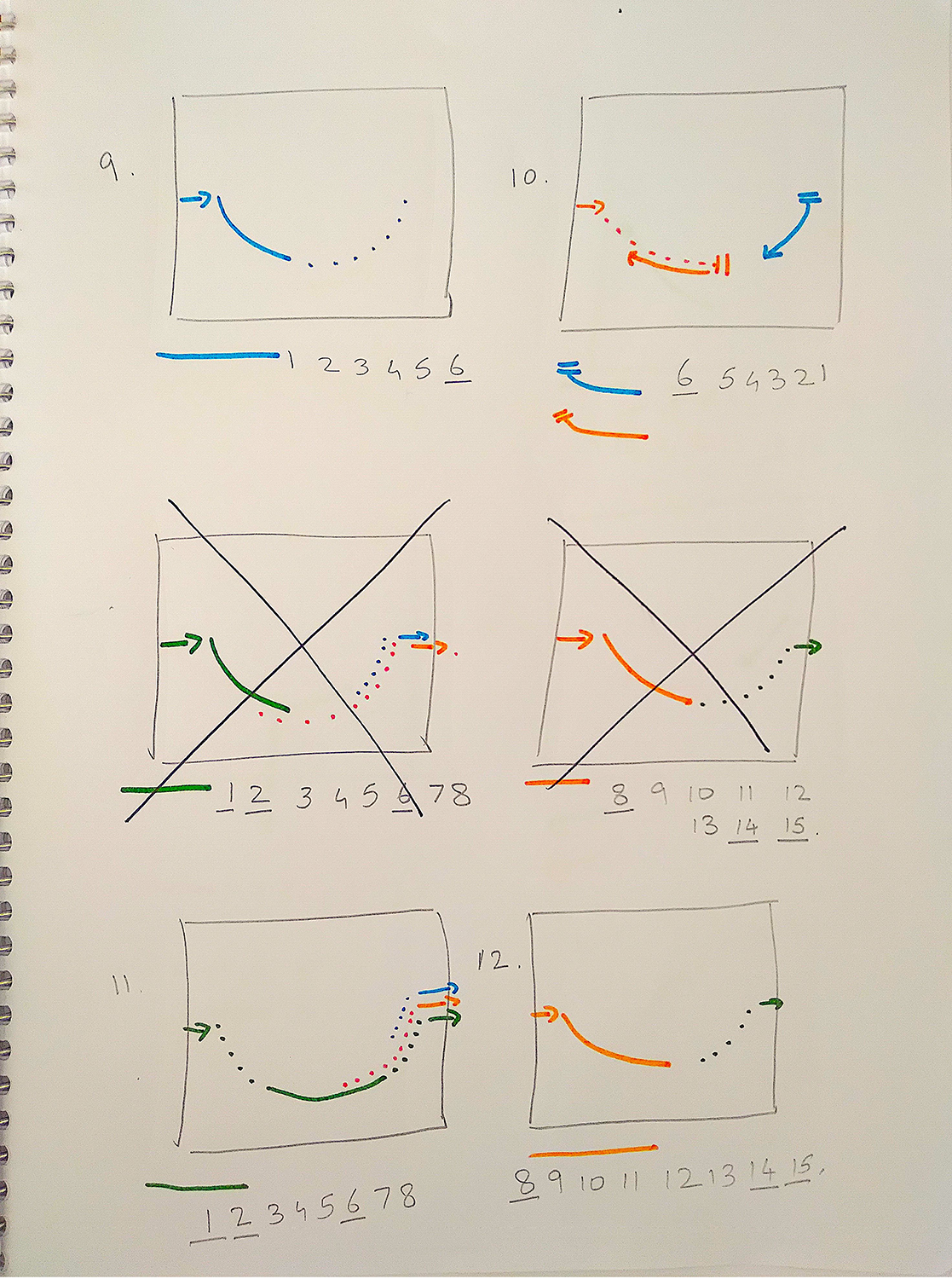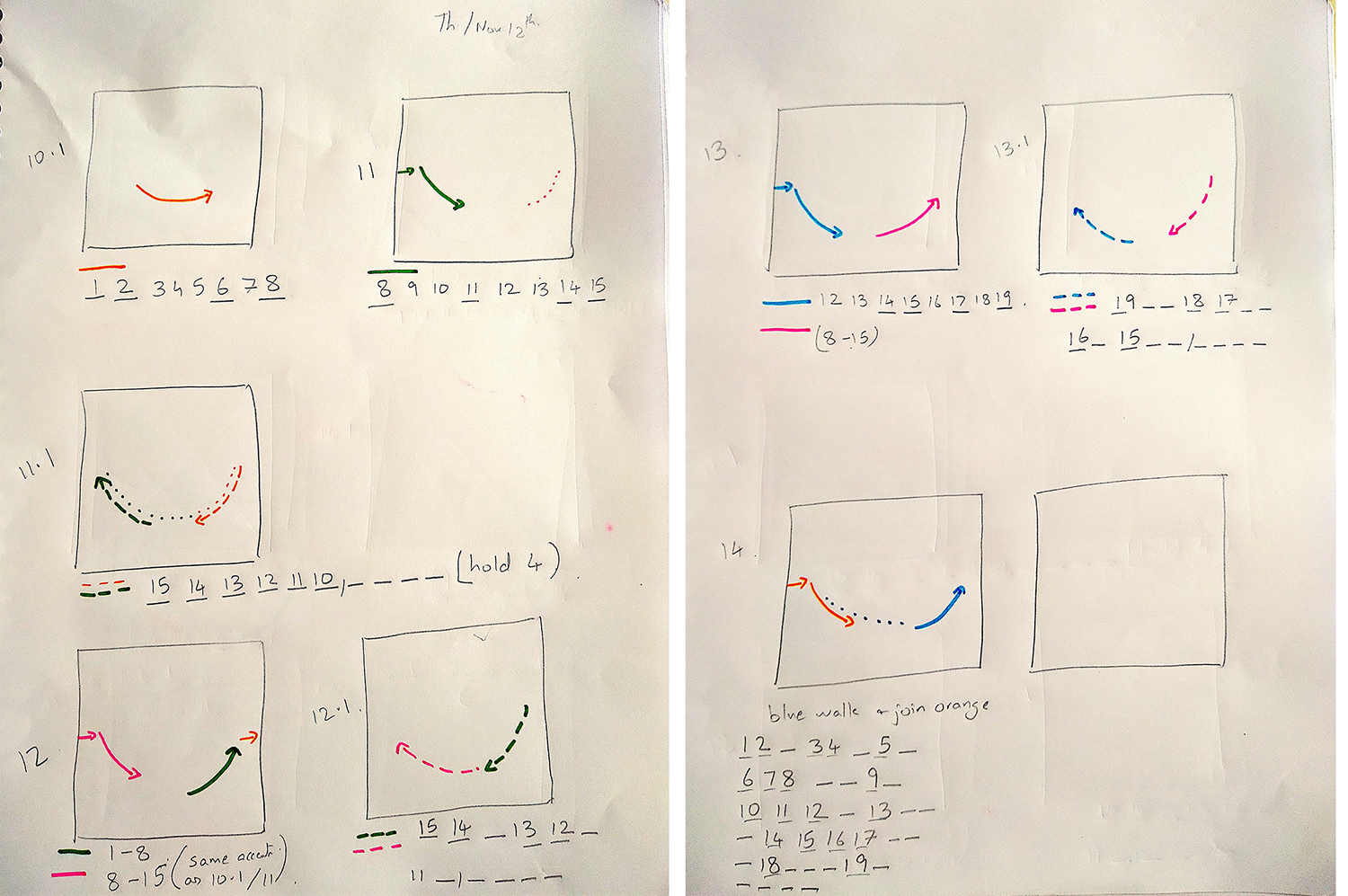Padmini Chettur
I encountered the dance score of Padmini Chettur in 2018, when we were preparing her archive-based exhibition in Yogyakarta (shortened Jogja), Indonesia. The exhibition was part of Jejak!Tabi Exchange: Wandering Contemporary Asian Performance*, a smallish, rather intimate artistic exchange platform I coinitiated, which took the form of a travelling festival. The dance score came in beautiful notebooks – several of them – and occupied one of the rooms, displayed side by side with her three-screen dance film, Varnam. They are sketches and scribbles in her handwriting. That marked our first collaboration as well as my deeper probing to understand an artist’s body of work as a totality and a peek into her ongoing process. Following is Padmini’s own deliberation (or critical musings) tracing the ‘origin’ of her dance scoring – her particular ways of embodying ideas – and how this translates into the choreographic process of her particular work, Chalking, that she created in 2020 in Toronto. I have not seen Chalking myself but it is perhaps the first time that Padmini worked with dancers other than the ones she trained herself in Chennai. Creating out of not only her usual habitus but also in times when live studio works were denied, replaced by a distant, online exchange conditioned by the new global situation, here’s some exposure on how her practice of scoring signifies her choreographing. (Helly Minarti)
* Please see some archives here, https://jejak-tabi.org/yogyakarta/
The sources
I come from a few systems of training the body – Bharatanatyam, Iyengar yoga, and kalarippayattu, wherein the geometric visualisation of the body and its relationship to space around it is clearly defined and prioritised. The musical tradition which supports Bharatanatyam – Carnatic music – works consistently with a way of ‘counting’ time and subdividing, upon which the dance was composed. This relationship of music and movement has multiple and quite complex manifestations – rhythmic and lyrical, narrative and abstract.
My entry and my reason for being a choreographer in the way that I am began in the studio of Chandralekha. She brilliantly reduced an essential grammar out of these multiple sources, and further pushed us – dancers – toward a deep understanding of our spines, our potential to not just ‘move into space’ (Laban), but to charge space.
Aside from my dance experience, I would also like to consider my university studies in chemistry as an important source for my thinking on structure, as well as my partner of 20 years – Maarten Visser – a saxophonist/composer with whom I have endlessly argued and learnt and been humbled through my discovery of incredibly complex and nuanced compositional thought that lies within the western musical tradition. Hence my use of the word ‘score’ itself comes with some trepidation and humility.
What is a score?
In the musical sense, a score indicates the use of a universal language. Any musician trained to read music can read a score, and possibly play it. In this sense, it is a tool for a composer to transcribe their musical imagination onto paper, and then share this with the musicians who would interpret. In western dance history, perhaps we trace the score back to Laban notation. In modernism and postmodernism, however, this idea of the score began to shift – John Cage, Simone Forti, and in the 1990s, choreographers like Thomas Lehman and Jonathan Burrows proposed radical democratising shifts in the way we consider the score. It could now be a simple set of instructions, propositions. To my mind, it often takes the form of the space in-between maker and performer.
All this, was not (as it is in no way complete) to write a ‘history of the score’, rather to say that in my practice, I use this medium of putting thoughts down on paper both as a way to visualise and create structured or temporal ideas – that derive heavily from traditions I learnt – as well as a medium of transmission. A way for dancers to not only learn their part but to see the larger composition. In this sense, every choreographers’ scores are deeply personalised systems. Specific, yet requiring another layer of transmission for the ‘reading’ to become dance.

From a workshop in Singapore based on Chalking
The system
“Time is more real than we are. When we dream, our physical body does not matter – what counts is our memory and the imaginative worlds we weave with the memory. And that is obviously temporal – not spatial.” – Jorge Luis Borges – Conversations with Osvaldo Ferrari
In March 2019, I was commissioned to make a work for Anandam Dance Theatre – Toronto by its artistic director Brandy Leary. The rest of this article will trace that process – which was largely over Zoom.
We began with an imagination of the body. We imagined the body as a singular vertical axis, and imagined invisible circular trajectories around this axis – head to foot, expanding and growing further away from it. Through several days of visualising and drawing, the dancers created material through which every action drew a part of an arc on one of their orbits. There were rules – the moving or ‘drawing’ body part had to retain its distance, its relationship to the central vertical. As we worked more and more with ‘plotting’ the movement, going back and forth between drawing and moving, details began to appear, growing out of the cracks of unclarity that the body proposes.
Out of this research, the dancers developed two phrases of movement – which could move them on the rim of the circle. We observed the tendency of a dancer to reduce the material to a set of meaningless actions unless the earlier visualisation of the rotational drawings was retained. This became a part of the pedagogy of training or warming up – as not to lose sight of the source – to reconnect with the unembodied ‘pure’ score.

The opening
As with some of my earlier works, my beginnings are often a revealing of the grammar. So, the phrase material was dismantled, and dancers were asked to repeatedly enter, and walk half a circular path to exit. With each iteration, starting with the skeletal idea of pivoting around the axis, to adding circular ideas from the phrase. Continuing till the arcs of movement elongated to reveal the entire phrase into which the idea of erasing (by reversal), fragmenting, and the temporal dynamic between dancers were inserted. Not being in the space with the dancers urged me to create scores that integrated the spatial and temporal, and it took a few iterations to understand how the translation of my thoughts on paper would work in its embodied form. This is the unscored/missing information that I referred to earlier. The gap is in the truth and accuracy of the score itself – especially in the case of my work, which relies heavily on uncluttered precision at all times.
Translation: score within a score
Within the first part of the work, (roughly fifteen minutes), we had two ideas of scores that we needed to reconcile – the early ‘Circularity’ drawings of the dancers and the larger-structured score of the choreography itself. To negotiate and balance both, the dancers were asked for multiple levels of attention, as well as the ability to visualise themselves in space. Furthermore – to refer back to Borges – it seemed as though this translation of the line on paper to the body in space, held within it an irrefutable temporality. The clarity, the thickness, the duration, the beginnings and endings of the drawn score required attention to the timings of the movement itself. In this context, the score translates from a set of purely visual clues, to a temporal proposition. The re-iteration or several re-iterations of the score went back and forth, geographically separated due to Zoom mediation. The digital process seemed to have a value that affected the choreographic decisions around the work. That could be interesting to consider – as a positive, rather than a negative result of online work.

I’d like to elaborate a bit more on the idea of ‘distance’ – both spatial and temporal – as a factor that pushes against the ideas of impulse, or
improvisation towards an infinitely detailed process of refinement – much like the multiple edits a writer must make. And further, every reading of this changed iteration of the score is, possibly, a process of underlining – including the recognition of errors and confusion. This back and forth has a cyclical movement – score to dancer and back again. Each circular repetition takes us closer to an idea of an inseparable existence where the dance becomes the score, the score the dance. Neither lives in the absence of the other, neither takes precedence over
the other. However, the question arises – how does one, then, think about the messy embodied nature of the dance itself, alongside the necessarily unembodied description of Borges’ score – the pure temporal.
I would like to propose, that within this method of moving from score to performance, lies an idea for performativity itself. Not so much through additional tips and pointers – extra information – but rather embedded within the simple task of not cluttering the clarity of the drawing through an excess. This ‘excess’ might be an interpretive choice or decision that a dancer makes, or it might be habits or mannerisms that unavoidably appear. In whatever way it happens, I have always tried to avoid this potentially sentimental baggage, in favour of a presence that arises out of the need to actualise the score. In a way, the dance is less about learning the score and demonstrating it, but
rather a process of making and retaining the visual clarity of the two-dimensional in a three dimensional space. As every dot, every line in the score has its relationship to the other dots and lines, every dancer – through reading the entire score, not merely a part – exists on a part of the larger collective body of the group. Every isolated movement resonates in the other bodies. Slowly, the stage space might fill up with the lines that are absent in the score. A bit like the filling in of an outline in a colouring book. The score is fleshed out, filled in this is the moment that we move from a purely ‘temporal’ score to a purely spatial enactment, where time and space co-exist within, outside, and in-between the physical bodies. Until we are unable to differentiate the two. Until the unembodied and the embodied are one and the same. There, dance begins.
Note: this article was written for Icelandic ‘Dunce magazine’ at the invitation of Indonesian curator Helly Minarti. It will be published end October in their special edition on scores.

Credits:
Production: Anandam Dancetheatre
Rehearsal Director: Harikishan S. Nair
Dancers: Atri Nandy, Robbert Kingsbury, Tanveer Alam, Nithya Garg, Brandy Leary
Leave A Comment